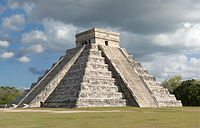This article needs additional citations for verification. (October 2022) |
| Part of a series on |
| Human history |
|---|
| ↑ Prehistory (Stone Age) (Pleistocene epoch) |
| ↓ Future |
In the history of the Americas, the pre-Columbian era, also known as the pre-contact era , or as the pre-Cabraline era specifically in Brazil, spans from the initial peopling of the Americas in the Upper Paleolithic to the onset of European colonization, which began with Christopher Columbus's voyage in 1492. This era encompasses the history of Indigenous cultures prior to significant European influence, which in some cases did not occur until decades or even centuries after Columbus's arrival.
During the pre-Columbian era, many civilizations developed permanent settlements, cities, agricultural practices, civic and monumental architecture, major earthworks, and complex societal hierarchies. Some of these civilizations had declined by the time of the establishment of the first permanent European colonies, around the late 16th to early 17th centuries,[1] and are known primarily through archaeological research of the Americas and oral histories. Other civilizations, contemporaneous with the colonial period, were documented in European accounts of the time. For instance, the Maya civilization maintained written records, which were often destroyed by Christian Europeans such as Diego de Landa, who viewed them as pagan but sought to preserve native histories. Despite the destruction, a few original documents have survived, and others were transcribed or translated into Spanish, providing modern historians with valuable insights into ancient cultures and knowledge.
- ^ "Early European Settlements in North America". Tripline. Retrieved 2017-05-06.


